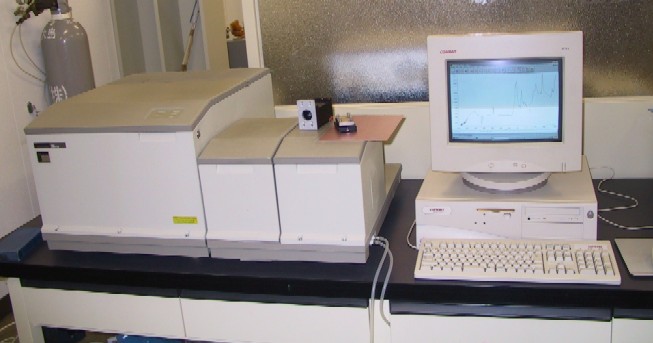|
|
 |
 |
|
 |
|
Supporting Research on the Synthesis of New Organic Molecules and Nano-Materials with Cutting-Edge Analysis Instruments |
 |
|
| |
Spectrophotometer (UV-Vis and FT-IR)
|
|
 Infrared Spectrophotometer (Room 1)
Infrared Spectrophotometer (Room 1)
Absorption of light in the infrared (IR) region (400-5000 cm-1) is dependent on the vibrational structure of a molecule. That is, the absorption is due to vibrational transitions accompanied by a number of rotational energy changes, and so, is observed as a vibrational-rotational “band”. The frequency or wave length of the absorption is closely connected with the mass, force constant, and geometry of the vibrational unit of the molecule. Therefore, IR spectra are useful for the structural analysis of the molecule.
The Center has a Perkin-Elmer System 2000 spectrometer (in Room 1), which is a Fourier Transform (FT) type using a modified Michelson interferometer. FT method and a laser beam system provide more precise and more accurate for the determination of the wavelengths of IR absorption peaks with higher sensitivity, compared to the measurements with a previous diffraction-grating type spectrometer. It is also possible to accumulate the spectral signal and perform time-resolved measurements. Mathematical treatments for the spectra, such as addition, subtraction, multiplication, division, integration, etc. are easily carried out. Furthermore, IR spectra of aqueous solutions are also available by using a HATR (horizontal attenuated total reflectance) accessory. |

UV-visible Spectrophotometer (Room 5)
Absorption of the ultraviolet (UV) and visible (Vis) light with a wavelength of 200-700 nm by a given molecule is dependent on its electronic structure. In other words, the origin of such absorption is a transition of electron in the ground state level to an upper level, and typical examples are the d-d transitions in the transition metal compounds and p-p* transitions in organic compounds with double bonds. Therefore, UV-vis absorption spectroscopy is used for identification and quantitative analysis of such types of compounds, and sometimes, for getting information on the electronic structure of unknown compounds.
This Center has a Hitachi 4000U UV-Vis spectrophotometer (in Room 5). Both transmission and reflection modes are available. |
| 2004.2.9 |
 |
|
 |
|



